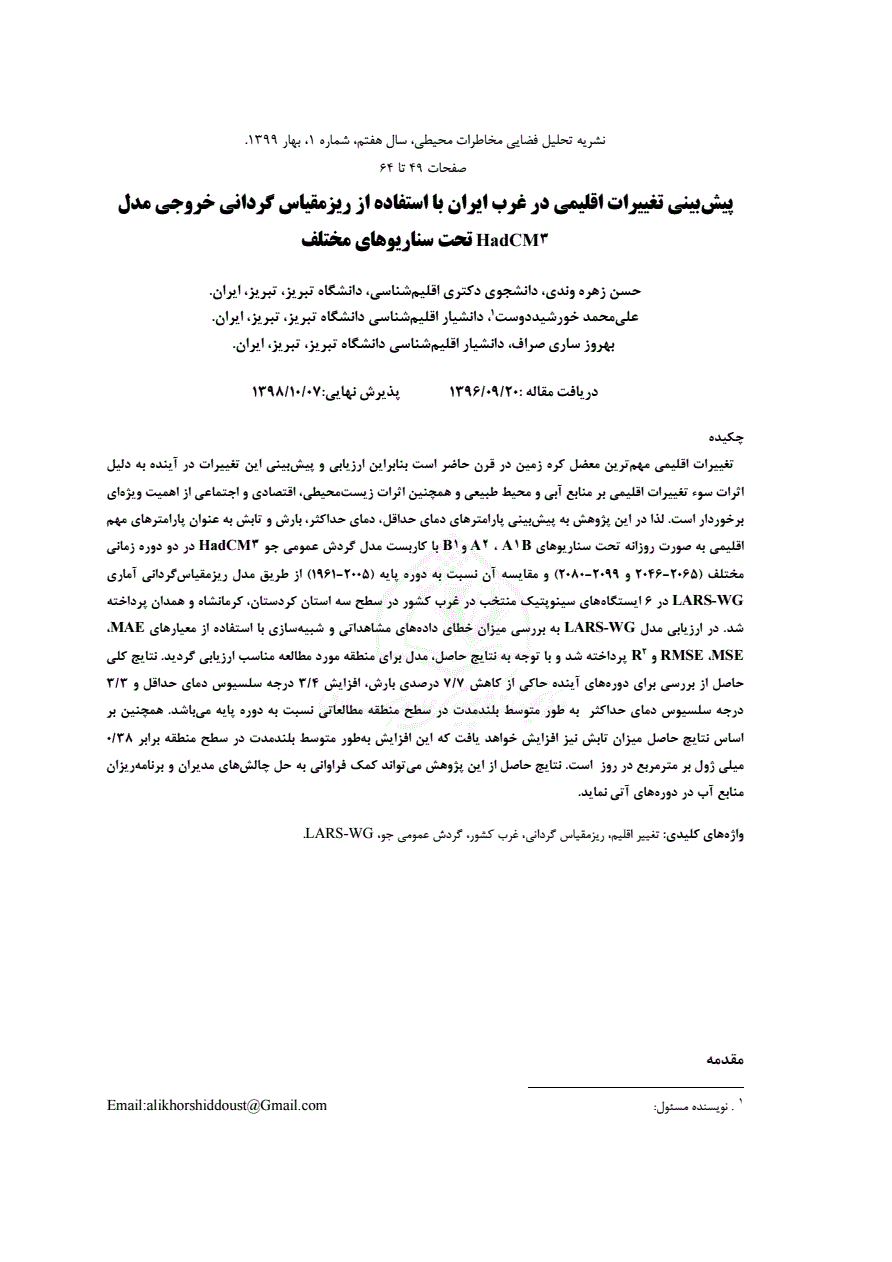چکیده:
تغییرات اقلیمی مهمترین معضل کره زمین در قرن حاضر است بنابراین ارزیابی و پیشبینی این تغییرات در آینده به دلیل اثرات سوء تغییرات اقلیمی بر منابع آبی و محیط طبیعی و همچنین اثرات زیستمحیطی، اقتصادی و اجتماعی از اهمیت ویژهای برخوردار است. لذا در این پژوهش به پیشبینی پارامترهای دمای حداقل، دمای حداکثر، بارش و تابش به عنوان پارامترهای مهم اقلیمی به صورت روزانه تحت سناریوهای A1B، A2 وB1 با کاربست مدل گردش عمومی جو HadCM3 در دو دوره زمانی مختلف (2065-2046 و 2099-2080) و مقایسه آن نسبت به دوره پایه (2005-1961) از طریق مدل ریزمقیاسگردانی آماری LARS-WG در 6 ایستگاههای سینوپتیک منتخب در غرب کشور در سطح سه استان کردستان، کرمانشاه و همدان پرداخته شد. در ارزیابی مدل LARS-WG به بررسی میزان خطای دادههای مشاهداتی و شبیهسازی با استفاده از معیارهای MAE، MSE، RMSE و R2 پرداخته شد و با توجه به نتایج حاصل، مدل برای منطقه مورد مطالعه مناسب ارزیابی گردید. نتایج کلی حاصل از بررسی برای دورههای آینده حاکی از کاهش 7/7 درصدی بارش، افزایش 4/3 درجه سلسیوس دمای حداقل و 3/3 درجه سلسیوس دمای حداکثر به طور متوسط بلندمدت در سطح منطقه مطالعاتی نسبت به دوره پایه میباشد. همچنین بر اساس نتایج حاصل میزان تابش نیز افزایش خواهد یافت که این افزایش بهطور متوسط بلندمدت در سطح منطقه برابر 38/0 میلی ژول بر مترمربع در روز است. نتایج حاصل از این پژوهش میتواند کمک فراوانی به حل چالشهای مدیران و برنامهریزان منابع آب در دورههای آتی نماید.
Considering that water resources are at risk from climate change, the study of temperature and precipitation changes in the coming years can lead to droughts such as droughts, sudden floods, high evaporation and environmental degradation. To this end, global climate models (GCMs) are designed to assess climate change. The outputs of these models have low spatial accuracy. In order to increase the spatial accuracy of this data, downscaling methods are used which are divided into statistical and dynamic methods. One of the reasons for using these models is their quick and easy operation compared to other methods. Our study area consists of Kurdistan, Kermanshah and Hamedan provinces in the west of the country. In this study, observational data of minimum temperature, maximum temperature, precipitation and radiation of 6 synoptic stations in the studied area in the statistical period of 1961 until 2005. In this study, the LARS-WG model was used for downscaling of HadCM3 global model data. The LARS-WG model is one of the most popular weather generator models that which to generation for maximum and minimum temperature, rainfall and radiation are used daily under current and future climate conditions. This model as a downscaled version of the same process less complex and simulated data input and output, high ability to predict climate change. The HadCM3 model is also a type of atmospheric- oceanic circulation model developed at the Hadley Center for Climate Prediction and Research, which has a 2.5 degree latitude network at 3.75 degrees longitude. Also, three climate change scenarios A1B, A2 and B1 have been used, each of which reflects the characteristics of the world's economic growth, the world's population and social awareness. The methodology is that the model receives the monitored data of the basic course; by examining them the statistical characteristics of the data are extracted. Then, in order to validate and ensure the model's capability for the basic statistical period, the model is implemented to re-establish a series of artificial data in the base period. Then the outputs to evaluate the performance of the model in the reconstruction of the data, the statistical characteristics of observations to test and compare various criteria. MAE, MSE, RMSE and R2 criteria were used to evaluate and analyze the performance of the downscaling model.
خلاصه ماشینی:
لذا در اين پژوهش به پيش بيني پارامترهاي دماي حداقل ، دماي حداکثر، بارش و تابش به عنوان پارامترهاي مهم اقليمي به صورت روزانه تحت سناريوهاي AB١ ، A٢ وB١ با کاربست مدل گردش عمومي جو HadCM٣ در دو دوره زماني مختلف (٢٠٦٥-٢٠٤٦ و ٢٠٩٩-٢٠٨٠) و مقايسه آن نسبت به دوره پايه (٢٠٠٥-١٩٦١) از طريق مدل ريزمقياس گرداني آماري LARS-WG در ٦ ايستگاه هاي سينوپتيک منتخب در غرب کشور در سطح سه استان کردستان ، کرمانشاه و همدان پرداخته شد.
صلاحي و همکاران (١٣٩٥) به پيش بيني تغييرات دما و بارش در دهه ٢٠٥٠ با استفاده از مدل LARS-WG و داده هاي خروجي مدل گردش عمومي HadCM٣ تحت سه سناريوي تغيير اقليم در حوضه آبريز درياچه پرداختند نتايج حاصل از پيش بيني مدل در دهه ٢٠٥٠ حاکي از کاهش ٨/٢٢ درصدي بارش و افزايش ٣/١ درجه سلسيوس دما در منطقه مطالعاتي نسبت به دوره پايه ميباشد.
(رجوع شود به تصویرصفحه) شکل ٣- تغييرات ماهانه پارامترهاي مورد برسي در ايستگاه همدان در دهه ٢٠٥٠ نتايج حاصل از خروجي مدل HadCM٣ بر اساس متوسط سناريوهاي مورد بررسي براي پارامترهاي اقليمي بارش ، دماي حداقل ، دماي حداکثر و تابش در ايستگاه هاي منتخب غرب کشور در طي دوره آماري پايه (٢٠٠٥-١٩٦١) و دو دوره زماني پيش بيني شده (٢٠٦٥-٢٠٤٦ و ٢٠٩٩-٢٠٨٠) در شکل هاي (٤ تا ٧) آورده شده است .

(پژوهیار,
,
,
)

